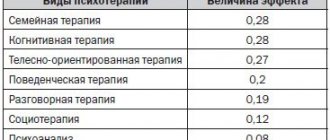The main functions of the human psyche and forms of its manifestation
Thus, the psyche arose at a certain stage in the development of living nature in connection with the formation in living beings of the ability to actively move in space. In the process of evolution, the psyche developed according to biological laws from the simplest to complex forms that are characteristic, for example, of monkeys. It should be noted that the human psyche is at a higher level of development than the psyche of animals. At the same time, the psyche is a form of active reflection by the subject of objective reality, which arises in the process of interaction of highly organized living beings with the outside world and carries out a regulatory function in their behavior (activity).
Rice. 7. Scheme of the emergence of psychic reflection
Mental reflection is not a mirror, mechanically passive copying of the world (like a mirror or a camera), it is associated with a search, a choice; in mental reflection, incoming information is subject to specific processing, that is, mental reflection is an active reflection of the world in connection with some necessity, with needs, it is a subjective selective reflection of the objective world, since it always belongs to the subject, does not exist outside the subject, depends on subjective features. The psyche is a “subjective image of the objective world”, it is a set of subjective experiences and elements of the subject’s internal experience.
In today's psychophysiology, the problem of the substrate of the psyche is also intensively discussed. The problem can be posed as follows: is the psyche simply a property of the nervous system, a specific reflection of its work, or does the psyche also have its own specific substrate? The only thing that can be said here for now is that the psyche cannot be reduced simply to the nervous system. Indeed, the nervous system is an organ (at least one of the organs) of the psyche. When the activity of the nervous system is disrupted, the human psyche suffers and is disrupted.
But just as a machine cannot be understood through the study of its parts and organs, so the psyche cannot be understood through the study of the nervous system alone. Perhaps the psyche also has its own substrate? Although the brain is an organ whose activity determines the psyche, the content of this psyche is not produced by the brain itself, its source is the external world.
The characteristics of mental processes are not derived only from the patterns of functioning of the brain that implements these processes. Mental phenomena are correlated not with a separate neurophysiological process, not with individual areas of the brain, but with organized sets of such processes. That is, the psyche is a systemic property of highly organized matter, which consists in the subject’s active reflection of the objective world, in the subject’s construction of a picture of this world that is inalienable from him and self-regulation on this basis of his behavior and activities.
Here we must pay attention to another important feature of the human psyche - the human psyche is not given in a ready-made form to a person from the moment of birth and does not develop on its own, the human soul does not appear on its own if the child is isolated from people. Only in the process of communication and interaction of a child with other people does he develop a human psyche, otherwise, in the absence of communication with people, nothing human appears in the child either in behavior or in the psyche (the Mowgli phenomenon). Thus, specifically human qualities (consciousness, speech, work, etc.), the human psyche are formed in a person only during his lifetime in the process of assimilating the culture created by previous generations. The psyche performs a number of different functions
(Fig. 8).
Rice. 8. Basic functions of the human psyche (according to B.F. Lomov)
1. Cognitive (cognitive) function.
The psyche is a property of the brain, its specific function. This function is in the nature of reflection. The mental reflection of reality has its own characteristics. Firstly, this is not a dead, mirror reflection, but a process that is constantly developing and improving, creating and overcoming its contradictions. Secondly, with the mental reflection of objective reality, any external influence is always refracted through previously established characteristics of the psyche, through specific human states. Therefore, the same impact can be reflected differently by different people and even by the same person at different times and under different conditions. Thirdly, mental reflection is a correct, true reflection of reality. Emerging images of the material world are snapshots, copies of existing objects, phenomena, and events.
2. Regulatory function. The human psyche and consciousness, on the one hand, reflect the influence of the external environment, adapt to it, and on the other hand, regulate this process, making up the internal content of activity and behavior. The latter cannot but be mediated by the psyche, since it is with its help that a person realizes his motives and needs, sets goals and objectives for his activity, and develops ways and techniques to achieve its results. Behavior in this case acts as an external form of manifestation of activity.
3. Communication function. The psyche ensures the process of exchanging information between a person and the outside world using signals and sign systems (speech). With the help of communication, a person is able to unite efforts with others like himself and direct them to achieve a goal. The need to organize joint activities was one of the prerequisites for the emergence of consciousness and pushed primitive man to the invention of speech communication. In the process of communication, a person shows his relationships to objects in the surrounding world and to other people; in the process of communication, relationships between people are established.
The totality of phenomena and processes studied by psychology, reflecting the basic content of the human psyche, represents the world of mental phenomena. The psyche is complex and diverse in its manifestations. Usually, three large groups of mental phenomena are distinguished, namely: 1) mental processes, 2) mental states, 3) mental properties (Fig. 9).
Mental processes. Mental processes are a dynamic reflection of reality in various forms of mental phenomena. A mental process is the course of a mental phenomenon that has a beginning, development and end, manifested in the form of a reaction. It must be borne in mind that the end of a mental process is closely related to the beginning of a new process. Hence the continuity of mental activity in a person’s waking state.
Rice. 9. Forms of manifestation of the human psyche
All mental processes are divided into cognitive - these include sensations, perception, memory, thinking and imagination, emotional - emotions and feelings, regulatory - attention and will.
Mental processes occur with varying speed and intensity depending on the characteristics of external influences and personality states. They ensure the formation of knowledge and the primary regulation of human behavior and activity.
V.P. Zinchenko defines attention as the process and state of the subject’s attunement to the perception of assigned tasks. Often in classifications of mental phenomena, attention is conventionally classified as cognitive processes, since attention itself does not carry any information, but “serves” all cognitive processes and makes them effective. Attention may also be associated with volitional processes (voluntary attention), or perhaps not associated with them (involuntary attention). Therefore, assigning attention to any category of mental phenomena poses a certain difficulty.
Mental states. A mental state should be understood as a psychological category, which includes different types of integrated reflection of the impact on the subject of both internal and external stimuli without a clear awareness of their substantive content. Or in other words, this is a certain level of performance and quality of functioning of the human psyche, characteristic of him at a given moment in time. Every person experiences different mental states every day. In one mental state, mental or physical work is easy and productive, in another it is difficult and ineffective.
Mental states are of a reflex nature: they arise under the influence of the situation, physiological factors, progress of work, time and verbal influences (praise, blame, etc.).
Mental properties are the highest and most stable regulators of a person’s mental activity. Mental properties of a person should be understood as stable formations that provide a certain qualitative and quantitative level of activity and behavior typical for a given person. Each mental property is formed gradually in the process of reflection and is consolidated in practice. It is therefore the result of reflective and practical activity.
Psychology Team of authors, 2020
5. Psyche and its main functions
1. Basic functions of the psyche
- closely interconnected reflection of objective reality and regulation of individual behavior and activity.
Psyche
- the property of highly organized living matter to reflect objective reality and, on the basis of the mental image formed in this case, it is advisable to regulate the activity of the subject and his behavior.
Reflection
- the ability of material objects in the process of interaction to reproduce in their changes the features and traits of the objects influencing them.
2. The form of reflection depends on the form of existence of matter. In nature, three main forms of reflection can be distinguished:
☑ physical form of reflection
, corresponding to the lowest level of organization of life, characteristic of the interaction of objects of inanimate nature;
☑ physiological form of reflection
;
☑ mental reflection
, the most developed and complex form, with the highest level of reflection specific to a person -
consciousness
.
Consciousness
- the highest level of mental reflection and regulation, inherent only to man as a socio-historical being.
Consciousness integrates the diverse phenomena of human reality into a truly holistic way of being and makes a person a Human.
Self-awareness
- the ability of the human psyche to separate itself, its own “I” from the life environment, to make its inner world, subjectivity a subject of comprehension, understanding, and most importantly - a subject of practical transformation.
It is self-consciousness that defines the boundary separating animal and human ways of being.
3. Features of mental reflection:
• subjectivity
, i.e., mediation by a person’s past experience and his individuality, we see one world, but it appears differently for each of us;
• objectivity
, since mental reflection still makes it possible to build an “internal picture of the world” that is adequate to objective reality;
• anticipatory character
: it makes possible anticipation in human activity and behavior.
Thanks to the regulation of behavior and activity, a person not only adequately reflects the surrounding objective world, but also has the opportunity to transform this world in the process of purposeful activity.
4. The psyche cannot be reduced simply to the work of the nervous system, since it represents a systemic quality of the brain
, implemented through multi-level functional systems of the brain, formed in a person in the process of life and his mastery of historically established forms of activity and experience of mankind through his own active activity.
Specifically human mental qualities
(consciousness, speech, work, etc.) are formed only during one’s lifetime, in the process of a person’s assimilation of the culture created by previous generations.
Composition of the human psyche
: the outside world, nature, its reflection, interaction with people, active transmission of culture and human abilities to new generations.
Regulatory functions
Schizothymics Read more: Kinesthetic sensations are a set of sensory information coming from muscles, tendons and ligaments
26. Regulatory functions
They are aimed at regulating internal mental processes, managing interaction with the outside world, and establishing relationships between people. Coordination of processes is carried out on the basis of unconditioned reflexes, the mechanics of which are innate and biologically determined. Manifested in instinctive reactions.
27. Sensation: definition, properties, types
Sensations are defined as the process of reflecting individual properties of objects and phenomena of the objective world during their direct impact on receptors. The physiological basis of sensation is a nervous process that occurs when a stimulus acts on an analyzer adequate to it. To this, perhaps, we can only add that sensations also reflect the state of the subject’s body with the help of receptors located in his body. Sensations are the initial source of knowledge, an important condition for the formation of the psyche and its normal functioning.
The need for constant sensations is clearly manifested in the case when there are no external stimuli (with sensory isolation). As experiments have shown, in this case the psyche ceases to function normally: hallucinations occur, thinking is impaired, pathology in the perception of one’s body is noted, etc. Specific problems of a psychological nature arise with sensory deprivation, i.e., when the influx of external influences is limited, which is well known from the example of the development of the psyche of people who are blind or deaf, as well as those with poor vision and hearing.
Human sensations are extremely diverse, although since the time of Aristotle, for a very long time they talked about only five senses - vision, hearing, touch, smell and taste. In the 19th century Knowledge about the composition of sensations has expanded dramatically as a result of the description and study of their new types, such as vestibular, vibration, “muscular-articular” or kinesthetic, etc.
Properties of sensations
Whatever the sensation, it can be described using several characteristics, properties inherent
To him.
1. Modality is a qualitative characteristic in which the specificity of sensation as a simple mental signal is manifested in comparison with a nervous signal. First of all, such types of sensations as visual, auditory, olfactory, etc. are distinguished. However, each type of sensation has its own modal characteristics. For visual sensations, these may be color tone, lightness, saturation; for auditory - pitch, timbre, volume; for tactile - hardness, roughness, etc.
2. Localization - spatial characteristics of sensations, i.e. Information about the localization of the stimulus in space.
Sometimes (as, for example, in the case of pain and interoceptive, “internal” sensations) localization is difficult and uncertain. The “probe problem” is interesting in this regard: when we write or cut something, the sensations are localized at the tip of the pen or knife, i.e. not at all where the probe comes into contact with the skin and affects it.
3. Intensity is a classic quantitative characteristic. The problem of measuring the intensity of sensation is one of the main ones in psychophysics.
The basic psychophysical law reflects the relationship between the magnitude of the sensation and the magnitude of the acting stimulus. Psychophysics explains the variety of observed forms of behavior and mental states primarily by differences in the physical situations that cause them. The task is to establish a connection between body and soul, an object and the feeling associated with it. The area of irritation causes sensation. Each sense organ has its own boundaries, which means there is an area of sensation. Such variants of the basic psychophysical law are known as the logarithmic law of G. Fechner, the power law of S. Stevens, as well as the one proposed by Yu.M. Zabrodin generalized psychophysical law.
4. Duration is a temporary characteristic of sensation. It is determined by the functional state of the sensory organ, but mainly by the time of action of the stimulus and its intensity.
The sensation occurs later than the stimulus begins to act, and does not disappear immediately with its cessation. The period from the onset of the stimulus to the onset of sensation is called the latent (hidden) period of sensation. It is not the same for different types of sensations (for tactile - 130 ms, for pain - 370 ms, for taste - 50 ms) and can change dramatically in diseases of the nervous system.
After the cessation of the stimulus, its trace remains for some time in the form of a consistent image, which can be either positive (corresponding to the characteristics of the stimulus) or negative (having opposite characteristics, for example, colored in an additional color). We usually do not notice positive consistent images because of their short duration. The appearance of sequential images can be explained by the phenomenon of retinal fatigue
Eyes.
Auditory sensations, similar to visual ones, can also be accompanied by sequential images.
The most comparable phenomenon in this case is “ringing in the ears”, i.e. an unpleasant sensation that often accompanies exposure to deafening sounds.
Types of sensations
With the help of kinesthetic and vestibular sensitivity, the individual is informed about his own movements and position in space.
Schizothymics Read more: Kinesthetic sensations are a set of sensory information coming from muscles, tendons and ligaments
Information about the job "Psychology"
Section: Psychology Number of characters with spaces: 56806 Number of tables: 0 Number of images: 0
Similar works
About immoralism in psychology
43170
0
0
... the causes of various kinds of disorders and disorders in some cases amount to 50%” (Hartley, Robach & Abramowitz.1976). Mass pop-psychological literature as a material carrier of immoralism Among psychologists and philosophers today, the theory of the activity approach to man is popular. Its representatives believe that knowledge about a person does not remain something external to the person studying it. It …
About the methodology of Christian psychology
23863
0
0
... fallen, perverted concepts. However, as the empirical research and practical procedures included in Christian psychology continue to develop and expand, it is necessary to periodically conduct a methodological analysis of the achieved state of the new discipline. Methodology as a reflexive mechanism of science, especially modern, very flexible general methodology, specifically ...
Psychologist: personality and craft
59831
0
0
... a necessary condition, but by no means sufficient for successful practical work. Practical work can also be different. When I start talking to students about personality psychology, I say that you can talk about personality psychology, or you can talk about personality; there are two different discourses, to use a word that is fashionable today. Using one logic, I can talk about how the area is built...
How do I understand psychology?
38440
0
0
... not so much to scientific-theoretical, logical thinking, which largely formalizes psychological information, but to associative, figurative, symbolic, contemplative thinking. When teaching psychology, it seems to us, one does not so much explain, generalize and memorize, but rather capture, feel and build (model) the moves of understanding and strategy already worked out by others...








